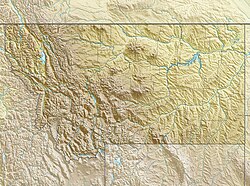| Bear Gulch Limestone | |
|---|---|
| Stratigraphic range: Late Serpukhovian (Namurian E2b), | |
 Echinochimaera meltoni, one of many unusual chondrichthyans found in the Bear Gulch Limestone | |
| Type | Lens |
| Unit of | Heath Formation |
| Thickness | 30-40 meters |
| Lithology | |
| Primary | limestone, shale |
| Other | siltstone |
| Location | |
| Coordinates | 46°57′N 109°00′W / 46.95°N 109°W |
| Country | |
| Extent | |
| Type section | |
| Named for | Bear Gulch, Montana |
The Bear Gulch Limestone is a limestone-rich geological lens in central Montana, renowned for the quality of its late Mississippian-aged fossils. It is exposed over a number of outcrops northeast of the Big Snowy Mountains, and is often considered a component of the more widespread Heath Formation. The Bear Gulch Limestone reconstructs a diverse, though isolated, marine ecosystem which developed near the end of the Serpukhovian age. It is a lagerstätte, a particular type of rock unit with exceptional fossil preservation of both articulated skeletons and soft tissues. Bear Gulch fossils include a variety of fish, invertebrates, and algae occupying a number of different habitats within a preserved shallow bay.[1][2]
Fish include a high diversity of unusual chondrichthyans (cartilaginous fish)[3][4] and one of the oldest known lampreys,[5] along with other vertebrates.[6] Invertebrates include numerous fossils of crustaceans, worms, cephalopods, and sea sponges, which are concentrated in different parts of the bay basin. Shelled cephalopods are abundant, and the Bear Gulch Limestone also preserves some of the best early fossils of coleoid cephalopods.[7][8] Fossils of typical benthic (seabed-attached) organisms are rare, and those that do occur are restricted to reef-like sponge patches in eastern exposures. This indicates that the conditions of the bay responsible for the Bear Gulch Limestone were at odds with other marine areas nearby.[2]
Some Bear Gulch fossils were preserved so rapidly and efficiently that mating behaviors,[9][10] internal organs,[11] coloration patterns,[12] gut content,[9][13] and even the pattern of blood vessels[11] could be observed in fossils. This exceptional preservation may be a consequence of the prevailing warm monsoonal climate, as storms could frequently and rapidly cover the seabed with oxygen-poor organic runoff from shallower areas.[2] Although up to 40 meters of sediment are found in the Bear Gulch Limestone, biostratigraphic data suggests that the lens was emplaced in only 1000 years, a geological instant.[6]
- ^ Cite error: The named reference
:4was invoked but never defined (see the help page). - ^ a b c Grogan, Eileen D.; Lund, Richard (2002). "The geological and biological environment of the Bear Gulch Limestone (Mississippian of Montana, USA) and a model for its deposition" (PDF). Geodiversitas. 24 (2): 295–315.
- ^ Lund, Richard; Poplin, Cécile (1999-01-01). "Fish diversity of the Bear Gulch Limestone, Namurian, Lower Carboniferous of Montana, USA". Geobios. 32 (2): 285–295. doi:10.1016/S0016-6995(99)80042-4. ISSN 0016-6995.
- ^ Cite error: The named reference
:6was invoked but never defined (see the help page). - ^ Cite error: The named reference
:34was invoked but never defined (see the help page). - ^ a b Lund, Richard; Greenfest-Allen, Emily; Grogan, Eileen D. (2012-07-15). "Habitat and diversity of the Bear Gulch fish: Life in a 318 million year old marine Mississippian bay". Palaeogeography, Palaeoclimatology, Palaeoecology. 342–343: 1–16. Bibcode:2012PPP...342....1L. doi:10.1016/j.palaeo.2012.04.016. ISSN 0031-0182.
- ^ Cite error: The named reference
:35was invoked but never defined (see the help page). - ^ Cite error: The named reference
:36was invoked but never defined (see the help page). - ^ a b Cite error: The named reference
:23was invoked but never defined (see the help page). - ^ Cite error: The named reference
:32was invoked but never defined (see the help page). - ^ a b Cite error: The named reference
:9was invoked but never defined (see the help page). - ^ Cite error: The named reference
:25was invoked but never defined (see the help page). - ^ Cite error: The named reference
:13was invoked but never defined (see the help page).
